Monarda, commonly known as Bee Balm, is a vibrant and versatile perennial that has become a favorite among gardeners. Known for its bright, tubular flowers and aromatic foliage, Monarda is not only visually appealing but also highly beneficial to garden ecosystems. With the ability to attract pollinators such as bees, butterflies, and hummingbirds, Monarda plays a crucial role in enhancing the biodiversity of any garden. Whether you’re an experienced gardener or just starting, growing Monarda can be a rewarding experience that adds both beauty and ecological value to your landscape. Our gardening blog is a perfect place to find all the information you need!
What is Monarda?
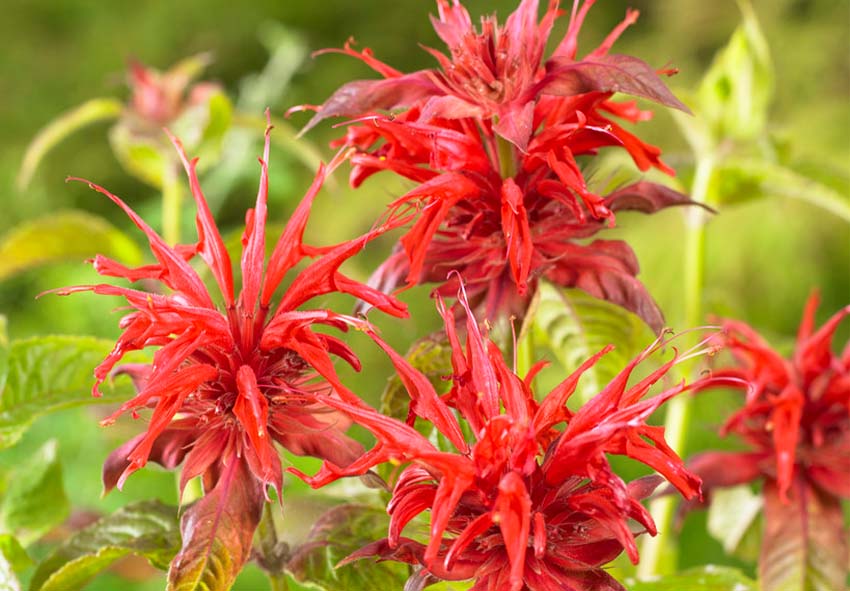
Monarda, often referred to as Bee Balm, is a member of the mint family (Lamiaceae) and is cherished for its striking flower clusters and fragrant leaves. This plant is native to North America and has been cultivated in gardens for centuries due to its ornamental appeal and medicinal properties. Monarda’s unique flowers, which range in color from deep red and pink to purple and white, bloom from mid-summer to early fall, making it a long-lasting addition to any garden.
Overview of Monarda (Bee Balm)
Monarda is a hardy perennial that thrives in a variety of garden settings. Its flowers are characterized by a whorled arrangement of tubular petals that resemble a crown, making it a standout in the garden. The plant typically grows between 2 to 4 feet tall and has a spreading habit, which can help fill in garden spaces effectively. Historically, Monarda has been used by Native American tribes for its medicinal properties, particularly for treating colds and digestive issues. Its leaves are also known for their strong, minty aroma, which can be used in teas and culinary dishes.
Popular Varieties of Monarda
Monarda comes in several popular varieties, each with its own unique characteristics:
| Variety | Color | Flowering Period | Fragrance | Usage |
| Monarda didyma (Scarlet Bee Balm) | Red | Mid-summer to early fall | Strong, minty aroma | Attracts hummingbirds, used in teas, ornamental |
| Monarda fistulosa (Wild Bergamot) | Lavender | Mid-summer to late summer | Sweet, herbal scent | Attracts bees and butterflies, used in herbal teas, medicinal |
| Monarda ‘Jacob Cline’ | Red | Mid-summer to early fall | Mild, minty aroma | Mildew-resistant, attracts pollinators, garden design |
| Monarda ‘Petite Delight’ | Pink | Mid-summer | Mild, minty aroma | Ideal for small gardens, containers, ornamental |
| Monarda ‘Raspberry Wine’ | Deep raspberry | Mid-summer to early fall | Light, fruity fragrance | Garden borders, attracts pollinators, ornamental |
Benefits of Growing Monarda
Growing Monarda offers numerous benefits, both ecological and practical. One of the primary reasons gardeners love Monarda is its ability to attract a wide range of pollinators. Bees, butterflies, and hummingbirds are all drawn to its nectar-rich flowers, which can help improve the overall health and productivity of your garden. By attracting pollinators and providing a habitat for beneficial insects, Monarda helps to enhance the biodiversity of your garden, making it a more resilient and self-sustaining ecosystem.
Moreover, Monarda has a long history of use in traditional medicine, particularly among Native American tribes. It was commonly used to treat colds, sore throats, and digestive issues, thanks to its antiseptic properties. The leaves and flowers of Monarda can be used in a variety of culinary applications, including herbal teas, salads, and garnishes, adding a unique, minty flavor to your dishes.
How to Plant Monarda
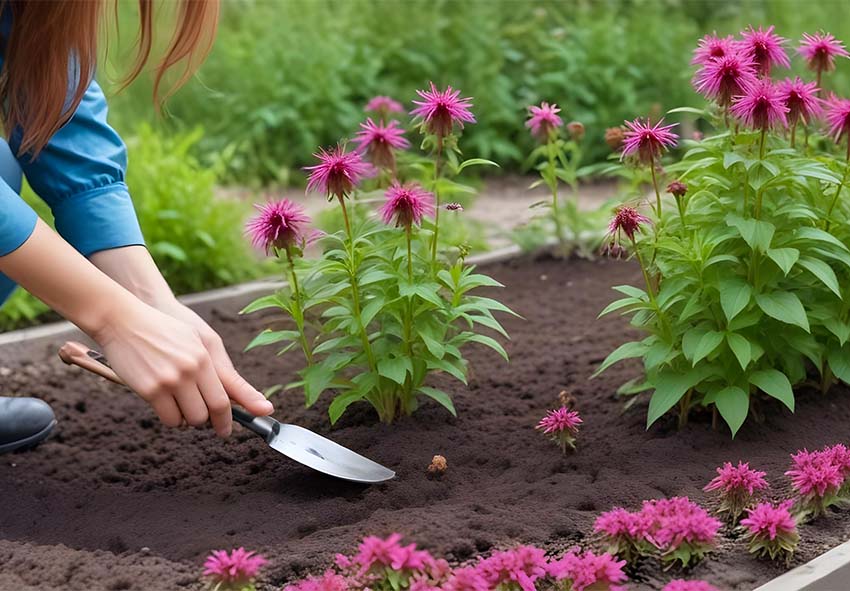
Planting Monarda is the first step to enjoying this vibrant and beneficial plant in your garden. By understanding the ideal growing conditions and following a simple planting process, you can ensure that your Monarda thrives and brings color and life to your outdoor space.
Ideal Growing Conditions
Monarda is relatively easy to grow and adapts well to various conditions, but it thrives best in specific environments:
- Soil Requirements: Monarda prefers well-drained soil with a pH level between 6.0 and 7.0. While it can tolerate a range of soil types, from sandy to clay, ensuring that the soil is rich in organic matter will promote healthier growth and more vibrant blooms.
- Sunlight and Temperature Preferences: Monarda grows best in full sun, which means at least 6 hours of direct sunlight per day. However, it can tolerate partial shade, especially in hotter climates. It is also fairly cold-hardy, making it suitable for growing in USDA zones 3-9.
Step-by-Step Planting Guide
Planting Monarda involves several key steps to ensure that your plants establish well and produce a bountiful display of flowers. First of all, the best time to plant Monarda is in the spring after the last frost has passed. Fall planting is also possible in milder climates, allowing the roots to establish before winter. Before planting Monarda, work the soil to a depth of about 12 inches and mix in compost or well-rotted manure to improve fertility and drainage. This preparation helps the roots to spread easily and absorb nutrients efficiently.
Monarda can be grown from seeds or transplants. If starting from seeds, sow them directly in the garden after the last frost, lightly covering them with soil. For transplants, dig holes that are slightly larger than the root ball, place the plant in the hole, and backfill with soil. Water thoroughly after planting to help the soil settle around the roots.
Monarda Care and Maintenance
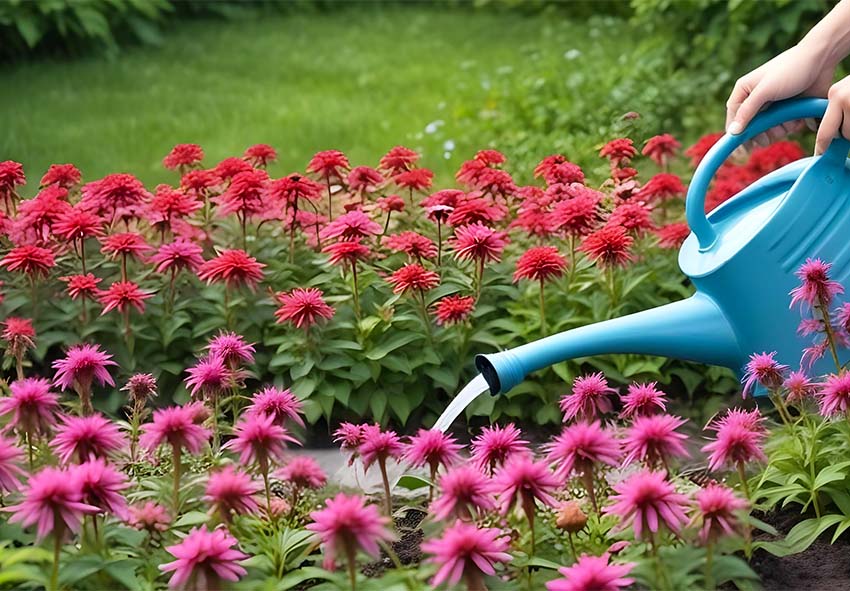
To keep your Monarda healthy and blooming throughout the season, proper care and maintenance are essential. This section covers watering, fertilization, pruning, and propagation techniques to help your plants flourish.
Watering and Fertilization
Monarda prefers consistently moist soil, especially during the growing season. Water the plants deeply once or twice a week, depending on rainfall and temperature. It’s important to avoid waterlogging the soil, as this can lead to root rot. While Monarda doesn’t require heavy feeding, applying a balanced, slow-release fertilizer in the spring can boost growth and flowering. An organic compost top-dressing can also provide essential nutrients throughout the growing season.
Pruning and Deadheading
Regular pruning helps to control the size of the plant and encourages bushier growth. In early spring, cut back any dead or damaged stems to make room for new growth. Mid-season pruning can also help manage height and spread. Besides, removing spent flowers, a process known as deadheading, can extend the blooming period of Monarda. Simply snip off the faded blooms just above the next set of leaves to encourage the plant to produce more flowers.
Propagation of Monarda
Monarda can be propagated easily, allowing you to expand your garden or share plants with others.
- Propagation Methods: The most common method of propagating Monarda is by division. Every 2-3 years, dig up the plant in early spring or fall, divide the root ball into sections, and replant the divisions in new locations. Monarda can also be propagated from seeds or cuttings.
- Tips for Successful Propagation: Ensure that each division has several healthy shoots and roots. When replanting, space the divisions at least 18 inches apart to give them room to grow. Water the new plants well and keep the soil consistently moist until they are established.
Pests and Diseases Control for Monarda
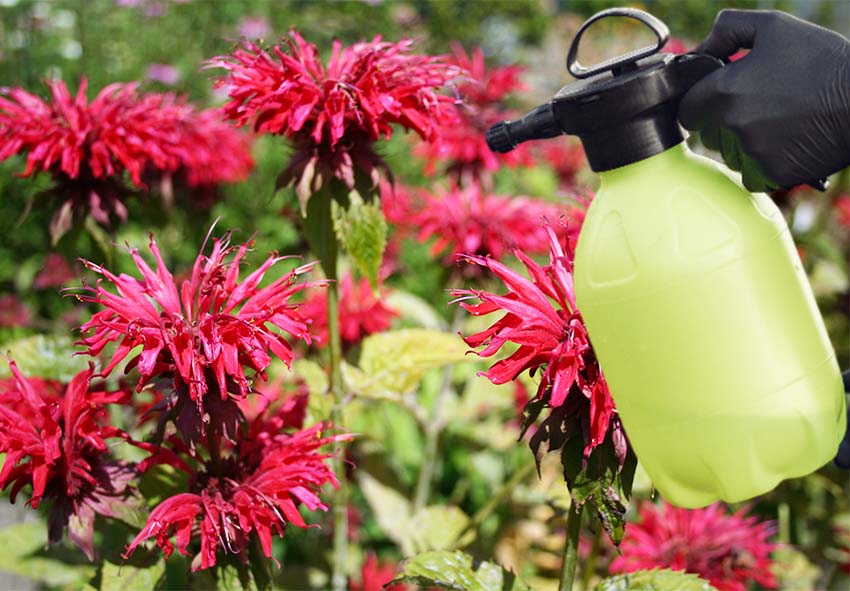
While Monarda is generally a hardy plant, it can occasionally face challenges from pests and diseases. Learn how to identify common problems and take preventive measures to protect your Monarda from these issues.
Common Pests
Several pests can affect Monarda, though they are usually manageable with proper care. Aphids, spider mites, and thrips are the most common pests that target Monarda. These insects typically feed on the sap of the plants, causing wilting, yellowing, and stunted growth. So, regularly inspect your plants for signs of pests, and if you spot any, treat them promptly with insecticidal soap or neem oil. Encouraging natural predators like ladybugs and lacewings can also help control pest populations.
Diseases and Solutions
Monarda is prone to a few diseases, particularly in humid conditions or when airflow around the plants is poor.
- Common Diseases: Powdery mildew is the most prevalent disease affecting Monarda, characterized by a white, powdery coating on the leaves. Root rot can also occur if the soil is consistently waterlogged.
- Organic and Chemical Treatment Options: For powdery mildew, removing and destroying infected leaves and improving air circulation around the plants can help manage the disease. Fungicidal sprays are also available for severe cases. To prevent root rot, ensure that the soil drains well and avoid overwatering.
- How to Prevent Disease Through Proper Care: Plant Monarda in well-spaced areas with good air circulation, and avoid overhead watering to reduce the risk of fungal infections. Regularly cleaning up fallen leaves and debris can also minimize disease risks.
Designing Your Garden with Monarda
Monarda is a versatile plant that can enhance various garden styles, from cottage to pollinator gardens. Discover how to pair Monarda with companion plants and integrate it into different garden designs for a beautiful and functional landscape.
Companion Plants for Monarda
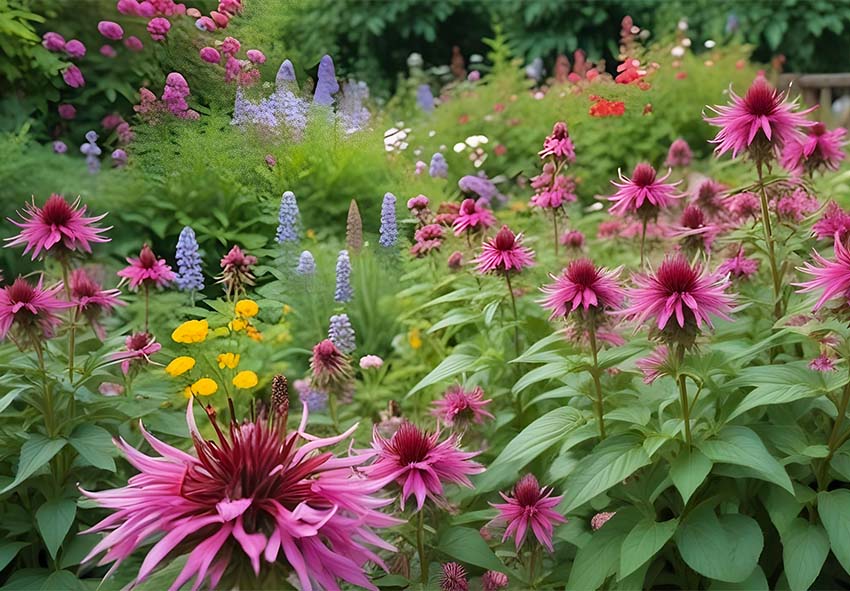
Choosing the right companion plants can enhance the beauty and health of your Monarda. Consider pairing Monarda with other sun-loving perennials such as Echinacea, Rudbeckia, and Phlox. These plants share similar growing conditions and create a visually appealing and pollinator-friendly garden. Use Monarda to add height and drama to the middle or back of flower beds, complementing shorter plants like Catmint or Salvia in front. The contrasting colors and textures will create a dynamic and attractive garden display.
Using Monarda in Different Garden Styles
Monarda’s versatility makes it suitable for various garden designs, from formal to naturalistic:
- Cottage Gardens: Monarda’s wild and informal appearance fits perfectly into cottage gardens, where it can be mixed with a variety of other flowering plants for a natural, free-flowing look.
- Pollinator Gardens: Given its attractiveness to bees, butterflies, and hummingbirds, Monarda is a must-have in pollinator gardens. Plant it alongside other nectar-rich plants to create a haven for pollinators.
- Herb Gardens: As a member of the mint family, Monarda can also be incorporated into herb gardens. Its leaves can be used in teas and as culinary herbs, making it both functional and decorative.
Harvesting and Using Monarda
Monarda offers more than just visual appeal; it can also be harvested and used in the kitchen. This section provides tips on when and how to harvest Monarda, along with creative ideas for incorporating its leaves and flowers into your culinary creations.
When and How to Harvest Monarda
Knowing when and how to harvest Monarda ensures you get the best flavor and fragrance from your plants. The best time to harvest Monarda is in the morning, after the dew has dried but before the heat of the day sets in. This is when the essential oils in the leaves and flowers are at their peak. Use sharp scissors or pruning shears to cut the stems just above a leaf node. Harvesting regularly can also encourage new growth and prolong the blooming period.
Ways to Use Monarda in the Kitchen
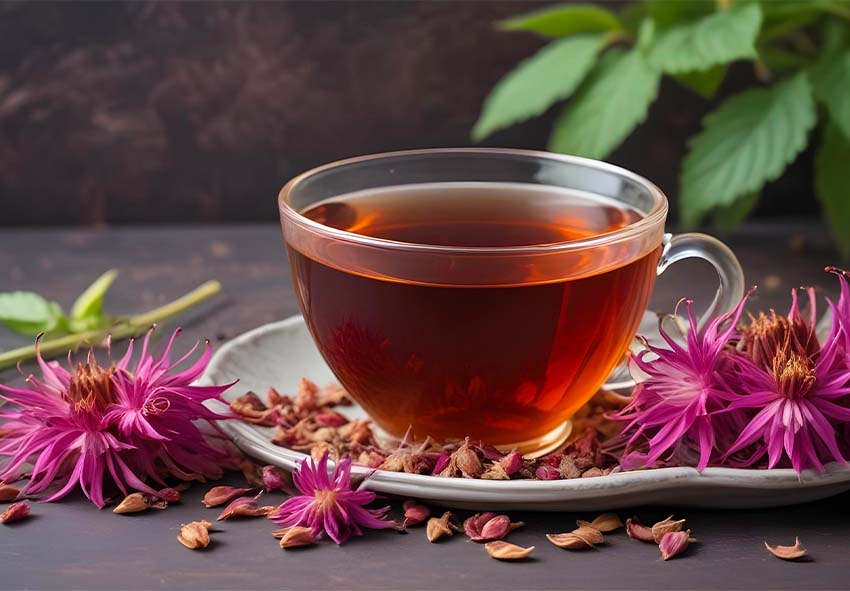
Monarda’s minty, citrus-like flavor makes it a versatile ingredient in the kitchen:
- Herbal Tea: Use fresh Monarda leaves to make a refreshing herbal tea that boasts a minty, citrus-like flavor. For added complexity, blend Monarda leaves with other herbs like lemon balm or mint to create a soothing and aromatic tea perfect for relaxation.
- Salad Additions: Add Monarda flowers to salads for a vibrant pop of color and a unique flavor that pairs well with fresh greens. The slightly spicy and minty taste of the flowers can elevate a simple salad, making it both visually appealing and delicious.
- Garnish for Desserts: Use Monarda flowers as an elegant garnish for desserts, adding both visual appeal and a hint of flavor. The flowers can be placed on cakes, tarts, or fruit dishes, providing a delicate and fragrant touch that compliments sweet flavors.
- Beverage Garnish: Enhance the presentation of beverages by garnishing them with Monarda flowers, which add a touch of natural beauty and a subtle, refreshing aroma. Perfect for cocktails, iced teas, or sparkling water, the flowers bring an extra element of sophistication to any drink.
Preserving Monarda
Preserving Monarda allows you to enjoy its flavors and fragrances year-round. To dry Monarda, tie small bundles of stems together and hang them upside down in a cool, dark, and well-ventilated area. Once fully dry, store the leaves and flowers in airtight containers away from direct sunlight. This will preserve their flavor and aroma for use in teas, potpourri, or cooking.
Conclusion
Monarda is a beautiful and beneficial addition to any garden, offering vibrant blooms, ecological benefits, and versatile uses in the kitchen and beyond. By following the right planting and care techniques, you can enjoy a thriving Monarda display that attracts pollinators, enhances biodiversity, and provides you with a range of culinary delights. Whether you’re new to gardening or an experienced enthusiast, growing Monarda is a rewarding experience that brings both beauty and function to your garden.
Frequently Asked Questions (FAQs) about Monarda
1. What is the best time of year to plant Monarda?
The best time to plant Monarda is in the spring, after the last frost has passed, or in early fall, allowing the plants to establish before winter. If planting in fall, do so at least 6-8 weeks before the first expected frost, giving the plants time to acclimate.
2. How do I prevent powdery mildew on my Monarda plants?
Ensure proper air circulation by spacing plants adequately and avoiding overcrowding. Water the plants at the base rather than overhead to keep foliage dry. Mulching around the base helps retain moisture without creating humidity. Regularly pruning to remove excess growth and deadheading spent flowers also reduces the risk of mildew.
3. Can Monarda be grown in containers or small gardens?
Yes, Monarda can be successfully grown in containers or small gardens. Choose a large container with good drainage, as Monarda has a spreading root system. Dwarf varieties like Monarda ‘Petite Delight’ are ideal for small spaces, offering vibrant blooms and the same pollinator benefits as larger varieties.
4. Can Monarda bulbs be ordered from your online store?
Yes! If you’re interested in adding Monarda to your garden, our online store Dutch-bulbs.com offers a selection of high-quality seeds and young plants. Please visit our website to explore our current Monarda offerings and place an order for the best option that suits your gardening needs.
5. How often should I water and fertilize Monarda?
Monarda requires regular watering, especially during dry spells, to keep the soil consistently moist but not waterlogged. Water deeply once or twice a week, depending on weather conditions. Monarda benefits from a balanced fertilizer applied in early spring as new growth begins.
Published: 20.08.2024
